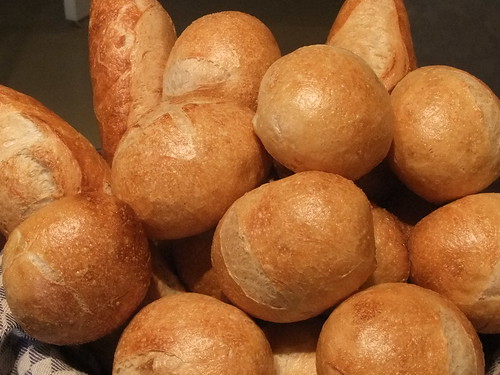
3 DAYS TO MAKE A DINNER ROLL?, originally uploaded by FatherDalton.
by Gerald Matthes
“Three days? You must be kidding!” That’s the response we sometimes get
when we explain that we use a process that spans three days to develop true
Artisan loaves and rolls.
It certainly doesn’t seem very efficient, does it? Now-a-days, commercial
bakeries have cut the time interval down to between eight and twelve hours.
The sheer volume they are involved in pretty much demands speeding up the
process. And to accomplish this, commercial yeast is used liberally, so that
doughs develop quickly.
On the positive side, the bakeries that adopt this methodology achieve an
improved profit picture. But at a cost. Inevitably, when it comes to making
bread, speed equals loss of flavor, texture, and shelf-life (unless
preservatives are added.)
The alternative to all these compromises in quality is to introduce an
additional ingredient called… time.
The value of doing so can be readily understood. Just as with the making of
fine cheese or the nurturing of exceptional wine, time is of paramount
importance. The same is true with great bread.
To ensure wonderfully complex flavors, bread needs time at key stages of
its development. Without getting too technical, here’s how it works:
Day One
Starters are prepared and allowed to ferment naturally – all day long and
all night long. True, Artisan bakeries use several different types of
starters. Each has it’s own characteristics and flavor enhancing
capabilities. The best known is a sourdough starter. Another is an Italian
Biga made with whole wheat flour. Another is called Poolish, which has a
pancake-like batter consistency. And then there is Pate Fermentee, which is
a piece of the previous day’s dough, which has been reserved.
These starters are the keys to real flavor in bread. In days gone by,
before the advent of commercial yeast, starters were used to make great
bread.
Day Two
After some twenty hours of fermentation, the starters have become active and
strong enough to be used instead of commercial yeast to cause bulk
quantities of dough to rise. These are then portioned into loaf size pieces,
which go back into the refrigerator for all day and all night long. Again,
time is playing its part. For all these hours, flavors are being enhanced.
The character of the bread is being developed.
Day Three
At last, the time has arrived for the loaves and rolls to be shaped by
skilled hands. (Not by machines, which impair the texture of the dough.)
Then they are given more time, to rise to perfection. After careful scoring
with a razor blade, the bread enters the hot (485? F) oven to be met by a
burst of steam. This produces the wonderful, crackly crust and a lovely
sheen. Some thirty minutes or so later, the bakery is filled with the
delicious aromas of beautiful golden loaves.
So, why do we go to all this trouble? Quite simply, because the result is a
world of difference – wholesome, real bread, full of flavor. Our forefathers
made bread this way and they understood the value of taking time to preserve
the qualities that endure.
We hope you’ll thoroughly enjoy the end result.
The Give Thanks Bakery in Downtown Rochester
Gerald S. Matthes, C.E.O.
225 South Main St., Rochester, MI 48307
248-601-1542
Hours:
Tues – Fri: 7:00 am – 3:00 pm
Sat: 7:00 am – 2:00 pm

